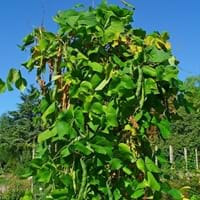Life Span
Perennial
Perennial
Origin
North America, Mexico, Central America
Central America
Types
Bigleaf hydrangea, Hortensia, Smooth hydrangea, Oakleaf hydrangea, Annabelle
Not Available
Number of Varieties
Not Available
Habitat
Forest edges, Hillside, Woods
Fields, orchards
USDA Hardiness Zone
Not Available
8-11
Sunset Zone
21,22
A1, A2, A3, H1, H2, 1a, 1b, 2a, 2b, 3a, 3b, 4, 5, 6, 7, 8, 9, 10, 11, 12, 13, 14, 15, 16, 17, 18, 19, 20, 21, 22, 23, 24
Habit
Prostrate/Trailing
Vining/Climbing
Minimum Width
Not Available
Flower Color
Brown, Sandy Brown
White, Red, Crimson
Flower Color Modifier
Bicolor
Bicolor
Fruit Color
Yellow green, Ivory
Green, Tan, Brown
Leaf Color in Spring
Green, Dark Green
Green, Dark Green
Leaf Color in Summer
Green, Dark Green
Green, Dark Green
Leaf Color in Fall
Not Available
Green, Dark Green
Leaf Color in Winter
Green
Green, Dark Green
Leaf Shape
Oblovate
Maple shaped
Plant Season
Not Available
Spring, Summer, Fall, Winter
Sunlight
Full Sun
Full Sun, Partial Sun
Growth Rate
Very Fast
Fast
Type of Soil
Loam, Sand
Clay, Loam, Sand
The pH of Soil
Neutral
Neutral
Soil Drainage
Well drained
Well drained
Bloom Time
Not Available
Indeterminate
Tolerances
Drought
Drought
Where to Plant?
Container, Ground
Container, Ground
How to Plant?
Seedlings, Stem Planting
Seedlings
Plant Maintenance
Medium
Medium
Watering Requirements
Not Available
Do not let dry out between waterings, Use Mulches to help prevent water loss during hot and windy weather
In Summer
Average Water
Lots of watering
In Spring
Moderate
Moderate
In Winter
Average Water
Average Water
Soil Type
Loam, Sand
Clay, Loam, Sand
Soil Drainage Capacity
Well drained
Well drained
Sun Exposure
Not Available
Full Sun, Partial Sun
Pruning
Remove damaged leaves, Remove dead branches, Remove dead leaves
Remove damaged leaves, Remove dead branches, Remove dead leaves
Fertilizers
All-Purpose Liquid Fertilizer
All-Purpose Liquid Fertilizer
Pests and Diseases
Red blotch
Red blotch
Plant Tolerance
Drought
Drought
Flower Petal Number
Single
Single
Foliage Texture
Coarse
Medium
Foliage Sheen
Matte
Matte
Attracts
Bees, Flies
Hummingbirds
Allergy
Chest tightness, Diarrhea, Dizziness, Nausea, Vomiting
Diarrhea, Irritation to stomach
Aesthetic Uses
Not Available
Not Available
Beauty Benefits
Not Available
Making cosmetics, Remove blemishes
Edible Uses
Not Available
Yes
Environmental Uses
Air purification
Air purification
Medicinal Uses
Fever, Kidney problems, Urinary tract problems
Acne, Diuretic, Emmoiliant, Menstrual Disorders
Part of Plant Used
Flowers, Root
Fruits
Other Uses
Not Available
Animal Feed, Used as a nutritious food item
Used As Indoor Plant
Not Available
Yes
Used As Outdoor Plant
Yes
Yes
Garden Design
Edible, Herb / Vegetable, Vine
Edible, Herb, Vegetable, Mixed Border, Tropical, Vine
Botanical Name
CUCURBITA pepo 'Table Gold Acorn'
PHASEOLUS coccineus
Common Name
Acorn Squash
Runner bean, Multiflora bean
In Hindi
Hydrangea
Scarlet Runner Bean
In German
Hortensie
Feuerbohne
In French
Hortensia
Haricot d'Espagne
In Spanish
Hortensia
Ayocote
In Greek
υδραγεία
Scarlet Runner Bean
In Portuguese
Hortênsia
Feijão-da-espanha
In Latin
Hibiscus
Scarlet Runner Bean
Phylum
Not Available
Spermatophyta
Class
Not Available
Magnoliopsida
Order
Not Available
Fagales
Family
Cucurbitaceae
Fabaceae
Genus
Not Available
Phaseolus
Clade
Not Available
Angiosperms, Eudicots, Rosids
Tribe
Not Available
Phaseoleae
Subfamily
Not Available
Faboideae
Number of Species
Not Available
Not Available
Importance of Acorn Squash and Scarlet Runner Bean
Want to have the most appropriate plant for your garden? You might want to know the importance of Acorn Squash and Scarlet Runner Bean. Basically, these two plants vary in many aspects. Compare Acorn Squash and Scarlet Runner Bean as they differ in many characteristics such as their life, care, benefits, facts, etc. Every gardener must at least have the slightest clue about the plants he wants to plant in his garden. Compare their benefits, which differ in many ways like facts and uses. The medicinal use of Acorn Squash is Fever, Kidney problems and Urinary tract problems whereas of Scarlet Runner Bean is Acne, Diuretic, Emmoiliant and Menstrual Disorders. Acorn Squash has beauty benefits as follows: Not Available while Scarlet Runner Bean has beauty benefits as follows: Not Available.
Compare Facts of Acorn Squash vs Scarlet Runner Bean
How to choose the best garden plant for your garden depending upon its facts? Here garden plant comparison will help you to solve this query. Compare the facts of Acorn Squash vs Scarlet Runner Bean and know which one to choose. As garden plants have benefits and other uses, allergy is also a major drawback of plants for some people. Allergic reactions of Acorn Squash are Chest tightness, Diarrhea, Dizziness, Nausea and Vomiting whereas of Scarlet Runner Bean have Diarrhea and Irritation to stomach respectively. Having a fruit bearing plant in your garden can be a plus point of your garden. Acorn Squash has showy fruits and Scarlet Runner Bean has showy fruits. Also Acorn Squash is not flowering and Scarlet Runner Bean is not flowering . You can compare Acorn Squash and Scarlet Runner Bean facts and facts of other plants too.





